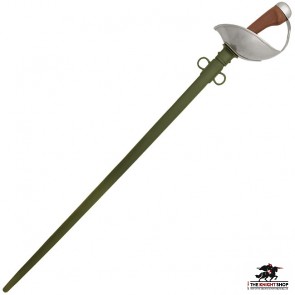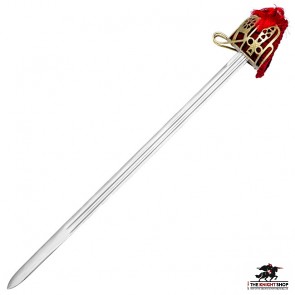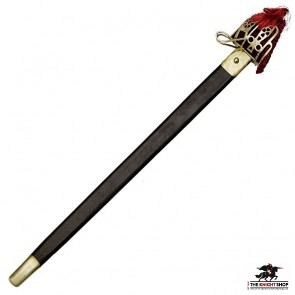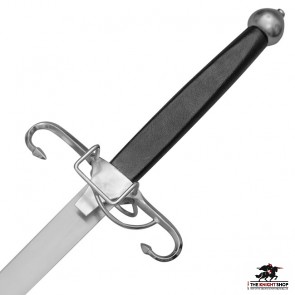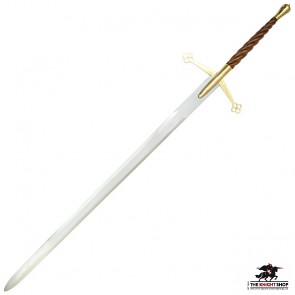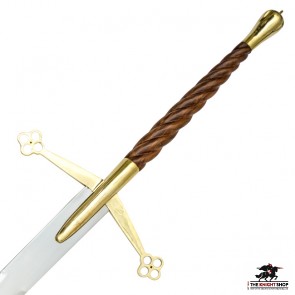Deepeeka Swords
-
Masonic Preceptor's Sword
The Freemasons of the 18th and 19th centuries gave the Masonic Sword as an award of rank and merit.
Learn More
Our Masonic Club sword has a richly adorned brass hilt with trefoil guard and pommel. The hand forged high carbon steel blade is housed in a leather scabbard with brass fittings.
Total length: 81 cm
Blade length: 66 cm
Grip length: 9 cm
Weight: 530 g
Blade thickness (base): 0.43 cm
Blade width (base): 1.2 cm
Point of Balance (PoB): 5 cm
Blade: High Carbon Steel
Edge: Blunt
Pommel: Threaded
Scabbard: Leather, Steel
All dimensions are approximate and may vary from piece to piece.Excl. Tax: £63.33 Incl. Tax: £76.00 -
Masonic Templar Sword
The Freemasons of the 18th and 19th centuries gave the Masonic Sword as an award of rank and merit.
Learn More
Our Masonic Templar Sword features the Templar seal emblazoned upon the pommel, Cross Patée and hand forged high carbon steel blade. Comes complete with leather scabbard with brass fittings.
Total length: 102 cm
Blade length: 86 cm
Grip length: 8 cm
Weight: 996 g
Blade thickness (base): 0.5 cm
Blade width (base): 2.4 cm
Point of Balance (PoB): 10 cm
Blade: High Carbon Steel
Edge: Blunt
Pommel: Threaded
Scabbard: Leather, Steel
All dimensions are approximate and may vary from piece to piece.Excl. Tax: £69.17 Incl. Tax: £83.00 -
Ceremonial Masonic Sword
The Freemasons of the 18th and 19th centuries gave the Masonic Sword as an award of rank and merit.
Learn More
Our Masonic Ceremonial Sword is inspired by a 19th century original. It features blackened hilt fittings that match the leather covered steel scabbard. The blade is forged from high carbon steel and is decorated with etchings along both sides of the blade.
Total length: 82.5 cm
Blade length: 68 cm
Grip length: 8.5 cm
Weight: 308 g
Blade thickness (base): 0.39 cm
Blade width (base): 1.06 cm
Point of Balance (PoB): 14.5cm
Blade: High Carbon Steel
Edge: Blunt
Pommel: Threaded
Scabbard: Leather, Steel
All dimensions are approximate and may vary from piece to piece.Excl. Tax: £63.33 Incl. Tax: £76.00 -
Renaissance Rapier
The rapier began to develop at around the turn of the 15th century as the Spanish espada ropera, or "dress sword". It was a fast and light single handed sword designed for cutting and thrusting. In 1570 the Italian swordmaster Signior Rocco Bonetti settled in England and advocated the use of the rapier for thrusting as opposed to cutting when engaged in a duel. Although it was generally seen as a civilian weapon, more robust versions such as the Pappenheimer Rapier were developed for battlefield use and saw service in conflicts such as the English Civil War. Many rapier treatises still survive including "The Schoole of the Noble and Worthy Science of Defence" written in England in 1617 by Joseph Swetnam.
Learn More
Our Renaissance Rapier features a hand forged complex hilt constructed from steel and polished to a bright finish. The wire-bound handle is both attractive and functional - allowing for a firmer grip than the leather bound equivalent. The hand forged steel blade is housed in a well made wooden scabbard with leather covering and steel fittings. This sword is blunt and designed for display only.
Total length: 100.5 cm
Blade length: 88.5 cm
Grip length: 18.5 cm
Weight: 1702 g
Blade thickness (base): 4.82 cm
Blade width (base): 0.5 cm
Point of Balance (PoB): 17 cm
Blade: High Carbon Steel
Edge: Blunt
Pommel: Threaded
Scabbard: Leather, Wood, Steel
All dimensions are approximate and may vary from piece to piece.Excl. Tax: £81.67 Incl. Tax: £98.00 -
British Cavalry Officer Sword - 1908 Pattern
The 1908 Pattern Cavalry Trooper's Sword was the last service sword issued to the cavalry of the British Army. It is widely considered the most effective cavalry sword ever designed, although ironically its introduction occurred as swords finally became obsolete as military weapons. This sword has a forged steel blade which has not been tempered so we would only recommend it for display only. Steel guard, wood grip and steel scabbard (painted green).
Learn More
Total length: 110 cm
Blade length: 89 cm
Grip length: 12 cm
Weight: 1400 g
Blade thickness (base): 0.97 cm
Blade width (base): 2.7 cm
Point of Balance (PoB): 7 cm
Blade: EN9 High Carbon Steel
Edge: Blunt
Pommel: Nut
Scabbard: Steel
All dimensions are approximate and may vary from piece to piece.Excl. Tax: £81.67 Incl. Tax: £98.00 -
British Cavalry Sword - 1912 Pattern
The 1908 Pattern Cavalry Trooper's Sword was the last service sword issued to the cavalry of the British Army. It is widely considered the most effective cavalry sword ever designed, although ironically its introduction occurred as swords finally became obsolete as military weapons. The 1912 Pattern British Cavalry Sword was introduced for officers, who had previously carried privately purchased non-regulation swords.
Learn More
The 1912 Pattern Sword was essentially the same as the 1908 Pattern but featured more decoration. The bowl shaped guard features an engraved floral pattern that was designed to mimic the honeysuckle pattern that was seen on officer’s swords in the 19th century. This sword has a blunt forged steel blade which has not been tempered so we would only recommend it for display only. Features a steel guard, leather wrapped grip and polished steel scabbard.
Total Length: 110cm
Blade Length: 89cm
Blade Width: 3cm
Depth Thickness: 0.4cm
Guard Width: 18cm
Grip Length: 16cm
Weight: 1028g
Blade: High Carbon Steel
Edge: Blunt
Pommel: Threaded
Scabbard: Steel
All dimensions are approximate and may vary from piece to piece.Excl. Tax: £75.83 Incl. Tax: £91.00 -
Jacobite Basket Hilt Sword
The iconic Basket Hilt Sword was wielded by Jacobite warriors during the rebellions of 1715 and 1745. It was usually partnered with the Scottish targe shield and was used to devastating effect during the Highland Charge! After the rebellion had been suppressed, the wearing of Scottish Basket Hilt swords, synonymous with Highland dress, was outlawed. However, the sword was adopted by officers of the Highland regiments in the 19th century.
Learn More
Our Jacobite Basket Hilt Sword features a brass basket with red cloth lining. The hand forged high carbon steel blade has a blunt edge and is housed in a leather covered wood scabbard.
Total length: 106 cm
Blade length: 89 cm
Grip length: 11 cm
Weight: 1600 g
Blade thickness (base): 0.5 cm
Blade width (base): 3.6 cm
Point of Balance (PoB): 20cm
Blade: High Carbon Steel
Edge: Blunt
Pommel: Threaded
Scabbard: Leather, Wood, Brass
All dimensions are approximate and may vary from piece to piece.Excl. Tax: £87.50 Incl. Tax: £105.00 -
The Stirling Monument William Wallace Sword
The William Wallace Sword on display at the Stirling Monument, Scotland, is alleged to have been used by Wallace at the battles of Stirling Bridge and Falkirk. After his execution in 1305, the sword is alleged to have been sent to John de Menteith, governor of Dumbarton Castle. In 1505, accounts show that James IV of Scotland paid 26 shillings to an armourer for "binding of Wallace's sword with cords of silk" and fitting it with "a new hilt and plummet" – which would account for the 16th century style hilt. A “new scabbard and a new belt” was also purchased at that time. Legend tells that the original scabbard and belt were made from the dried skin of Hugh Cressingham, one of the English Commanders at the Battle of Stirling Bridge.
Learn More
Our William Wallace Sword is a replica of the one displayed at the Stirling Monument. It features a huge 136cm blade, the total length of the sword being an intimidating166cm! The 16th century style hilt fittings are made from solid steel and feature a leather-wrapped wooden grip. This impressive sword has a blunt blade and is designed for display only.
Please note: The extreme length of the forged blade means that it is too flexible for anything but display. The blade may also have imperfections such as a slight twist or curve (that wouldn’t be noticed when hanging on a wall unless you were looking for it). The original sword on display in the Sterling Monument, has a blade made from 3 separate swords welded together and is certainly not free from imperfections.
Overall Length: 166cm
Blade Length: 136cm
Blade Width: 5cm
Blade Thickness: 0.5cm
Guard Width: 28cm
Guard Depth: 15cm
Grip Length: 26cm
Weight: 2.6kg
Blade: High Carbon Steel
Edge: Blunt
Pommel: Threaded
Scabbard: None
All dimensions are approximate and may vary from piece to piece.Excl. Tax: £133.33 Incl. Tax: £160.00 -
Two Handed Scottish Claymore
The Claymore (from the Scottish Gaelic claidheamh-mòr, meaning “great sword”) is a Scottish variant of the late medieval 2 handed sword. It differed from other longswords of the period in that it usually had forward sloping quillons terminating in quatrefoils. Claymores were in use during constant clan warfare and fights with the English from the 15th to 17th century. Claymores did exist as early as the Wars of Scottish Independence although they were smaller and few had the characteristic quatrefoil design. The last time that claymores were seen on the battlefield in any significant number was the Battle of Killiecrankie in 1689.
Learn More
Our Two Handed Scottish Claymore has a hand-forged high carbon steel blade topped with solid steel hilt fittings and a stained real wood grip. This sword has a blunt blade and is designed for display only.
Overall Length:123cm
Blade Length: 92cm
Blade Width: 5.8cm
Blade Thickness: 0.5cm
Guard Width: 29cm
Guard Depth: 2.9cm
Grip Length: 19cm
Blade: High Carbon Steel
Edge: Blunt
Pommel: Peened
Scabbard: None
All dimensions are approximate and may vary from piece to piece.Excl. Tax: £104.17 Incl. Tax: £125.00 -
Twisted Hilt Scottish Claymore
The Claymore (from the Scottish Gaelic claidheamh-mòr, meaning “great sword”) is a Scottish variant of the late medieval 2 handed sword. It differed from other longswords of the period in that it usually had forward sloping quillons terminating in quatrefoils. Claymores were in use during constant clan warfare and fights with the English from the 15th to 17th century. Claymores did exist as early as the Wars of Scottish Independence although they were smaller and few had the characteristic quatrefoil design. The last time that claymores were seen on the battlefield in any significant number was the Battle of Killiecrankie in 1689.
Learn More
Our Twisted Hilt Scottish Claymore features a hand-forged high carbon steel blade topped with brass hilt fittings and a hand carved real wood grip. This sword has a blunt blade and is designed for display only.
Overall Length: 143cm
Blade Length: 106.5cm
Grip Length: 23cm
Weight: 2294g
Blade thickness (base): 0.5 cm
Blade width (base): 5 cm
Point of Balance (PoB): 19.5 cm
Blade: High Carbon Steel
Edge: Blunt
Pommel: Peened
Scabbard: None
All dimensions are approximate and may vary from piece to piece.Excl. Tax: £81.67 Incl. Tax: £98.00















